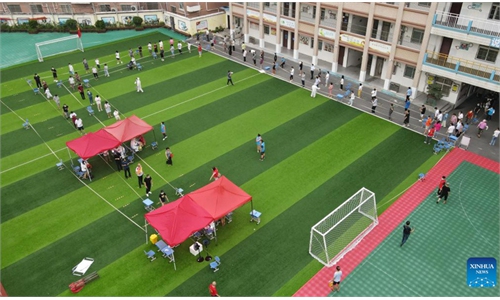China mulls further reduction of quarantine period, more precise anti-epidemic measures

People seal the gate of a makeshift hospital in Shanghai on May 25, 2022, marking the official close of the facility. Photo: IC
China is mulling whether to further shorten the quarantine period and impose more precise anti-epidemic restrictions, as part of its efforts to optimize the COVID-19 response, health authorities said on Thursday amid Omicron BA.5 subvariant-dominated outbreaks in at least 20 Chinese provinces and regions.
Observers viewed it as a positive signal to adjust its anti-epidemic measures in a more science-based way so as to fit the changing epidemic situation. "One-size-fits-all" measures in some regions that have led to "adding additional barriers to anti-virus policies" will be further scrapped to reach a better balance among epidemic control, maintaining people's lives and economic growth, they believed.
"We will continue to collect and study new problems and difficulties that locals are facing in dealing with COVID-19 outbreaks in following the ninth COVID-19 prevention playbook, such as whether the quarantine period can be further shortened and low-risk areas can be more precisely classified… so as to further update and improve the anti-epidemic measures to minimize the impact of the epidemic prevention and control measures on China's economic and social development and people's lives," Wang Liping, a research fellow at the Chinese Center for Disease Control and Prevention (China CDC), said during a Thursday press briefing.
Wang said that building better coordination among provinces on identifying people carrying a COVID-19 risk so as to reduce risks of trans-regional transmission is being studied.
Commenting on these fresh actions, virologist Jin Dongyan from Hong Kong University told the Global Times on Thursday that "it's good to see China's dynamic zero-COVID policy has always been dynamically adjusted as the epidemic situation changes. It is definitely more science-based."
If infected cases can be more easily tracked and quarantined, it is possible to shorten their quarantine period to three days at the minimum, Jin noted.
He explained that neither BA.4 nor BA.5 show any big difference from other subvariants in terms of incubation periods. But data proves that most infected cases with BA.4 or BA.5 are prone to infect others within three days after a positive test, which means it is possible to shorten the quarantine period to three days at a minimum.
A Beijing-based health expert told the Global Times on condition of anonymity that "the possible adjustment indicates the flexibility of China's anti-epidemic policy. Shortening quarantine period doesn't mean the country is ready to relax its anti-epidemic determination, but is making its anti-epidemic measures more precise."
The expert said that the government will continue rectifying some local governments' "one-size-fits-all" measures that have led to "adding additional barriers to anti-virus policies," to make sure the science-based measures are well implemented across the country and better balanced among anti-virus measures and maintaining people's lives, as well as economic growth.
Another reasonable adjustment that Wang noted on Thursday is that mass nucleic acid testing can exclude people living in regions that have clear transmission origins and clear chains, with no cases of community spread. Mass testing only covers regions of COVID-19 risks.
On June 28, China cut the period in centralized quarantine of international arrivals and close contacts of COVID-19 patients from 14 days to seven days, and it drew a clear standard on what constitutes medium- and high-risk areas in its latest updated COVID-19 prevention playbook.
Dong Xiaoping, chief virology expert at the China CDC, said at Thursday's press conference that the current COVID-19 response measures are still effective in dealing with two dominant virus types in China - the BA.5 and BA.4 subvariants - though they are of stronger transmission capability than the rest of Omicron's subvariants.
Jin also told the Global Times that if the vaccination rate in China, especially among vulnerable groups such as the elderly, can be raised further, the country's anti-epidemic measures can be better optimized, as the subvariants reported in this round of outbreaks in China have a strong capacity to escape an immune response.
Chinese academician Zhang Boli said that the severe disease rate during this round of the epidemic caused by BA.5 is very low - about one out of nearly 2,000 - which could be explained by the enhanced herd immunity following mass vaccination.
Virologist Dong said the monitoring of new variants regarding their transmission capability, virulence and capacity to escape an immune response will be a long-term target of the China CDC. Most scholars at home and abroad believe that the novel coronavirus variants will exist for a long time, and the Omicron variant will not be the last, Dong noted.
More than 20 provincial-level regions in the Chinese mainland have reported locally transmitted COVID-19 cases, and daily caseloads have begun to tick up in recent days. The latest COVID-19 flare-ups have hit smaller cities in some provinces such as East China's Anhui Province and Northwest China's Gansu Province, showing a rising risk, as smaller regions face greater challenge due to limited medical resources and increasing financial pressure.


